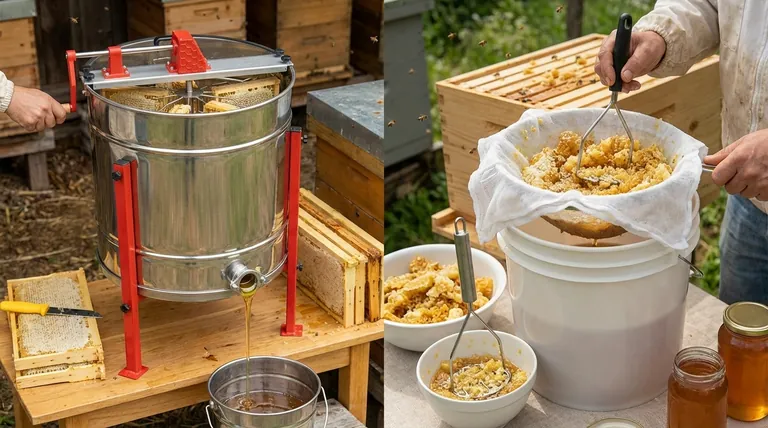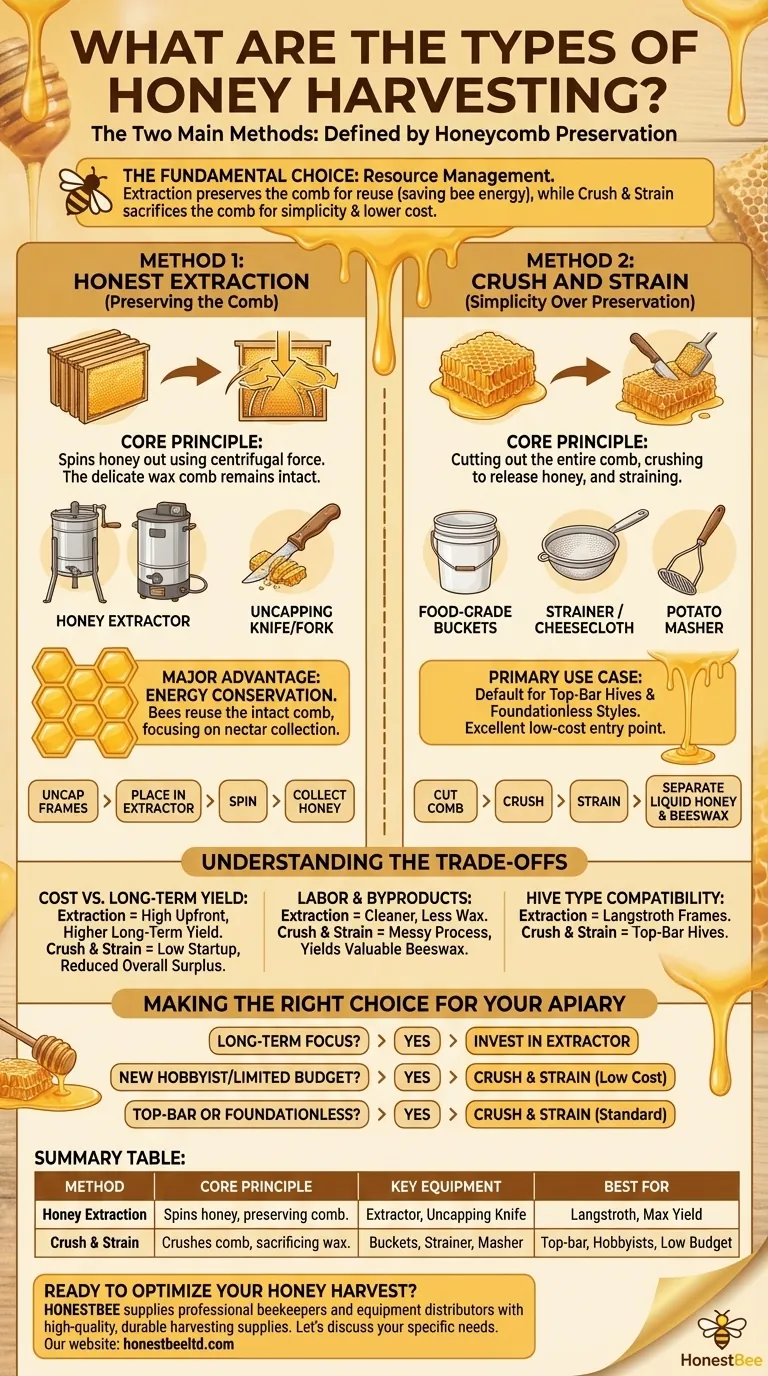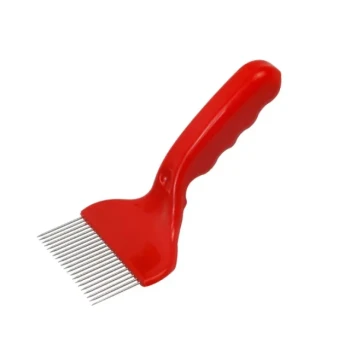When harvesting honey, beekeepers primarily choose between two distinct methods that are defined by one critical factor: whether or not the honeycomb is preserved. The most common techniques are honey extraction, which uses centrifugal force to save the comb, and the crush and strain method, which sacrifices the comb for simplicity and a lower initial investment in equipment.
The fundamental choice in honey harvesting is not just about equipment, but about resource management. Extraction preserves the bees' hard work by keeping the comb intact for reuse, while the crush and strain method sacrifices the comb for simplicity and lower initial cost.

Method 1: Honey Extraction (Preserving the Comb)
Honey extraction is the standard for most beekeepers using Langstroth hives because it maximizes the hive's long-term efficiency.
The Core Principle
This method spins honey out of the capped cells using centrifugal force. The delicate wax comb remains intact within the frame, ready to be returned to the hive for the bees to refill.
Key Equipment Required
The primary tool is a honey extractor, which can be a hand-cranked manual device or a larger electric model. You will also need an uncapping knife or fork to slice off the thin wax cappings that seal the honey cells.
The Major Advantage: Energy Conservation
The most significant benefit is preserving the comb. Bees expend a tremendous amount of energy and resources to produce wax and build comb. By giving them empty, intact comb to refill, you save them this effort, allowing them to focus entirely on nectar collection and honey production.
The Process at a Glance
First, the beekeeper uses a hot knife or fork to carefully slice the wax cappings off both sides of the frame. The uncapped frames are then placed inside the extractor. Spinning the extractor slings the honey out against the drum wall, where it drains to the bottom and is collected.
Method 2: Crush and Strain (Simplicity Over Preservation)
The crush and strain method is a low-tech, straightforward approach that is perfectly suited for small-scale operations or for hives that do not use frames with foundation.
The Core Principle
As the name implies, this method involves cutting out the entire comb, crushing it to break open the cells, and then straining the mixture to separate the liquid honey from the solid beeswax.
Key Equipment Required
This method requires minimal specialized equipment. As noted, you will need two food-grade buckets, a strainer or cheesecloth, and a knife. A simple tool like a potato masher is used to crush the comb.
The Primary Use Case
This is the default method for top-bar hives and other foundationless beekeeping styles where the comb is not supported by a rigid frame. It is also an excellent entry point for new beekeepers with only one or two hives who want to avoid the cost of an extractor.
Understanding the Trade-offs
Neither method is universally "better"; the right choice depends entirely on your goals, budget, and beekeeping style.
Cost vs. Long-Term Yield
An extractor is a significant upfront investment. However, by preserving the comb, it enables bees to produce more honey over the season and subsequent years, leading to a much higher long-term yield. The crush and strain method has almost no startup cost but forces the bees to rebuild comb every time, reducing their overall honey surplus.
Labor and Byproducts
Crush and strain is simple but can be a sticky, messy process. However, it yields a large amount of clean beeswax, which is a valuable byproduct. Extraction is generally cleaner but only provides a small amount of wax from the cappings.
Hive Type Compatibility
The type of hive you use often makes the decision for you. Standard Langstroth frames with foundation are designed for extraction. The delicate, unsupported comb from a top-bar hive would disintegrate in an extractor, making crush and strain the only viable option.
Making the Right Choice for Your Apiary
Your harvesting technique should align directly with your beekeeping philosophy and the scale of your operation.
- If your primary focus is long-term honey production and hive efficiency: Investing in an extractor is the most effective path forward.
- If you are a new hobbyist with one or two hives and a limited budget: The crush and strain method is a perfectly viable and low-cost way to get started.
- If you use top-bar or other foundationless hives: Crush and strain is your standard and necessary method for harvesting honey.
Choosing the right method aligns your equipment with your beekeeping goals, ensuring a successful and rewarding harvest.
Summary Table:
| Method | Core Principle | Key Equipment | Best For |
|---|---|---|---|
| Honey Extraction | Spins honey out using centrifugal force, preserving the wax comb. | Extractor, Uncapping Knife | Langstroth hives; maximizing long-term honey yield. |
| Crush & Strain | Crushes the honeycomb to release honey, sacrificing the wax. | Buckets, Strainer, Masher | Top-bar hives, hobbyists, low-budget startups. |
Ready to Optimize Your Honey Harvest?
Choosing the right harvesting method is crucial for your apiary's efficiency and profitability. Whether you manage a large commercial operation or are a growing distributor, having the right equipment is key.
HONESTBEE supplies professional beekeepers and equipment distributors with high-quality, durable honey harvesting supplies. We can help you equip your operation for maximum yield, whether you need reliable extractors for comb preservation or essential tools for the crush and strain method.
Let's discuss your specific needs. Contact our expert team today to find the perfect harvesting solutions for your business.
Visual Guide

Related Products
- 6 Frame Manual Stainless Steel Honey Extractor Beekeeping Equipment
- Stainless Steel 3 Frame Manual Honey Extractor Spinner for Bee Honey Extraction
- Plastic Hand Crank 2 Frame Honey Extractor Low Price
- electric honey extractor honey centrifuge 3 frame honey extractor stainless steel honey frame extractor
- HONESTBEE 3-Frame Manual Acrylic Honey Extractor
People Also Ask
- How many frames can different types of honey extractors hold? Maximize Your Harvest Efficiency
- What are the key stages of honey extraction? A Complete Guide for Beekeepers
- What are some tips for using a honey extractor effectively? Maximize Your Honey Yield and Protect Your Comb
- Which type of extractor is more suitable for hobbyists or small-scale beekeepers? Find the Perfect Fit for Your Apiary
- What is the relationship between beeswax harvesting and honey extraction? An Inseparable Process Explained



















